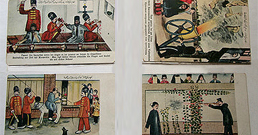The very first post card was printed in Austria in 1869, quickly followed by other European countries in subsequent years. With the progress of photography and the printing ofattractive pictures on post cards, they became very popular not only as a means of correspondence but as collectors’ items too.
The introduction of post cards in Iran began in the late 19th century when Iranians visiting Europe sent cards back to their relatives and friends. Soon post cards were produced locally, depicting various scenes or pictures of historical and contemporary personalities. Images of important political and religious figures in the Constitutional Revolution period were a particularly popular and often repeated theme. Some cards were quite plain with only a postage stamp carrying the picture of the reigning Qajar shah printed at the corner.
In Iran, as in other parts of the world, there are enthusiastic post card collectors. Nasseroddin Hasanzadeh’s fascination was sparked off more than 20 years ago when he began dealing in rare old books. In the course of his business he came across many old documents, including post cards, which he decided to collect.
His collection so far includes more than 300 post cards, particularly of the Qajar period and of the Constitutional Revolution, rare photographs, as well as hand-written letters and notes by prominent political, artistic, literary or religious figures of various periods. The oldest document in his collection is an agreement for the sale of land dating back to the reign of Shah Abbas in 1607. He has had three exhibitions at the Museum of Photography in Tehran and donated several documents to the Tabriz Museum of the Constitutional Revolution.
In this multimedia report, we are invited to view many items in this diverse and fascinating collection of rare post cards and documents.


